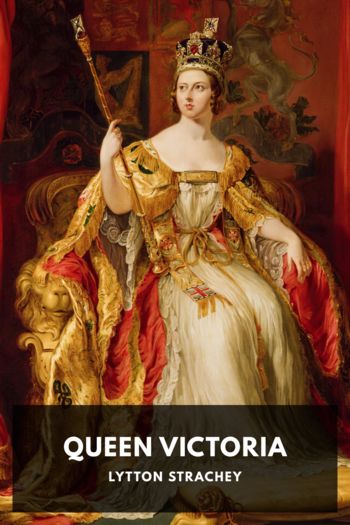Queen Victoria, Lytton Strachey [best books for 8th graders .TXT] 📗

- Author: Lytton Strachey
Book online «Queen Victoria, Lytton Strachey [best books for 8th graders .TXT] 📗». Author Lytton Strachey
And it was not only the place that she loved; she was equally attached to “the simple mountaineers,” from whom, she said, “she learnt many a lesson of resignation and faith.”384 Smith and Grant and Ross and Thompson—she was devoted to them all; but, beyond the rest, she was devoted to John Brown. The Prince’s gillie had now become the Queen’s personal attendant—a body servant from whom she was never parted, who accompanied her on her drives, waited on her during the day, and slept in a neighbouring chamber at night. She liked his strength, his solidity, the sense he gave her of physical security; she even liked his rugged manners and his rough unaccommodating speech. She allowed him to take liberties with her which would have been unthinkable from anybody else. To bully the Queen, to order her about, to reprimand her—who could dream of venturing upon such audacities? And yet, when she received such treatment from John Brown, she positively seemed to enjoy it. The eccentricity appeared to be extraordinary; but, after all, it is no uncommon thing for an autocratic dowager to allow some trusted indispensable servant to adopt towards her an attitude of authority which is jealously forbidden to relatives or friends: the power of a dependent still remains, by a psychological sleight-of-hand, one’s own power, even when it is exercised over oneself. When Victoria meekly obeyed the abrupt commands of her henchman to get off her pony or put on her shawl, was she not displaying, and in the highest degree, the force of her volition? People might wonder; she could not help that; this was the manner in which it pleased her to act, and there was an end of it. To have submitted her judgment to a son or a Minister might have seemed wiser or more natural; but if she had done so, she instinctively felt, she would indeed have lost her independence. And yet upon somebody she longed to depend. Her days were heavy with the long process of domination. As she drove in silence over the moors she leaned back in the carriage, oppressed and weary; but what a relief—John Brown was behind on the rumble, and his strong arm would be there for her to lean upon when she got out.
He had, too, in her mind, a special connection with Albert. In their expeditions the Prince had always trusted him more than anyone; the gruff, kind, hairy Scotsman was, she felt, in some mysterious way, a legacy from the dead. She came to believe at last—or so it appeared—that the spirit of Albert was nearer when Brown was near. Often, when seeking inspiration over some complicated question of political or domestic import, she would gaze with deep concentration at her late husband’s bust. But it was also noticed that sometimes in such moments of doubt and hesitation Her Majesty’s looks would fix themselves upon John Brown.
Eventually, the “simple mountaineer” became almost a state personage. The influence which he wielded was not to be overlooked. Lord Beaconsfield was careful, from time to time, to send courteous messages to “Mr. Brown” in his letters to the Queen, and the French Government took particular pains to provide for his comfort during the visits of the English Sovereign to France. It was only natural that among the elder members of the royal family he should not have been popular, and that his failings—for failings he had, though Victoria would never notice his too acute appreciation of Scotch whisky—should have been the subject of acrimonious comment at Court. But he served his mistress faithfully, and to ignore him would be a sign of disrespect to her biographer. For the Queen, far from making a secret of her affectionate friendship, took care to publish it to the world. By her orders two gold medals were struck in his honour; on his death, in 1883, a long and eulogistic obituary notice of him appeared in the Court Circular; and a Brown memorial brooch—of gold, with the late gillie’s head on one side and the royal monogram on the other—was designed by Her Majesty for presentation to her Highland servants and cottagers, to be worn by them on the anniversary of his death, with a mourning scarf and pins. In the second series of extracts from the Queen’s Highland Journal, published in 1884, her “devoted personal attendant and faithful friend” appears upon almost every page, and is in effect the hero of the book. With an absence of reticence remarkable in royal persons, Victoria seemed to demand, in this private and delicate matter, the sympathy of the whole nation; and yet—such is





Comments (0)